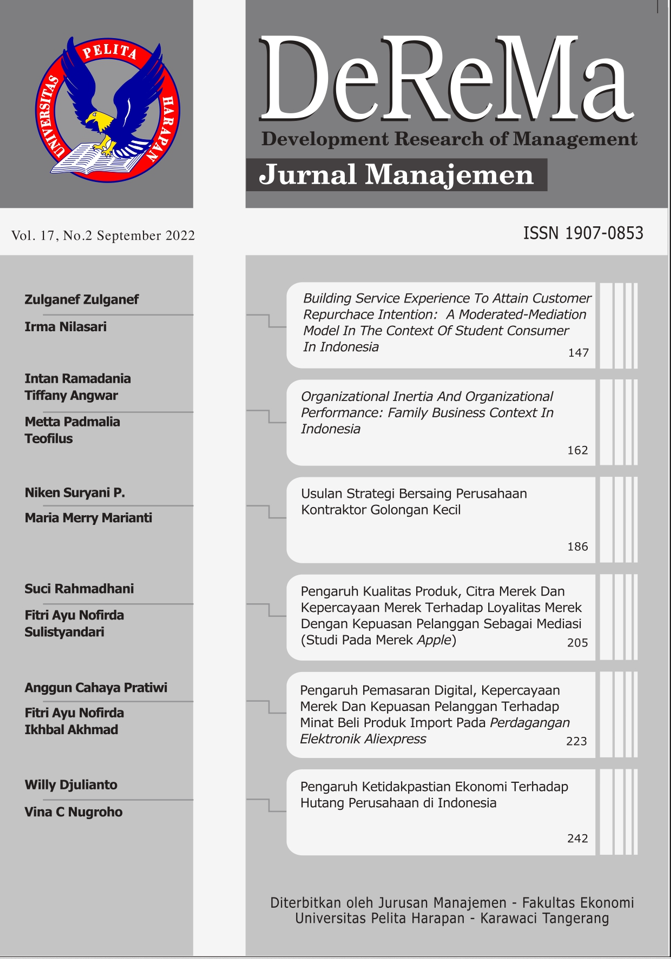USULAN STRATEGI BERSAING PERUSAHAAN KONTRAKTOR GOLONGAN KECIL [PROPOSED COMPETITIVE STRATEGIES OF SMALL CONTRACTOR COMPANIES]
##semicolon##
https://doi.org/10.19166/derema.v17i2.5277##semicolon##
QSPM analysis##common.commaListSeparator## marketing strategy##common.commaListSeparator## Keunggulan##common.commaListSeparator## kelemahan##common.commaListSeparator## peluang##common.commaListSeparator## persaingan##common.commaListSeparator## strategi要旨
The construction industry is one such sector that is quite promising with regards to governmental support in this area. The needs of the Indonesian State regarding development are one of the key factors for the improvement of this sector. The construction industry consists of several groups; the small groups are often the target of competitive businesses within the industry, which often creates a negative impact on their expansion and growth. This makes the government support for small construction service providers a crucial stage in enabling them to compete with larger companies; one of which is CV. IWK. This company currently relies upon, and utilizes, the owner's extensive experience within the sector and its overall quality of work. However, the company has yet to focus on its marketing and workforce to fully capitalize on its potential growth, thereby, it tends to find it difficult to meet project targets and obligations. The company needs to maximise its strengths and further its current position in the sector by employing an appropriate strategy to implement continued penetration of the market via internal development. This is reinforced by the results of the QSPM analysis which shows that this strategy is the best choice for the company in moving forward in such a competitive market. To succeed, the main focus for the company is to delegate labor to the marketing function.
Abstrak dalam Bahasa Indonesia. Sektor konstruksi menjadi salah satu sektor yang cukup menjanjikan, dukungan pemerintah dan kebutuhan negara Indonesia mengenai pembangunan menjadi salah satu faktor menggeliatnya sektor ini. Sektor konstruksi terdiri dari beberapa golongan, golongan kecil sering menjadi sasaran dampak negatif dari kompetisi antar industri, hal ini yang menjadikan pemerintah mendukung adanya dukungan terhadap penyedia jasa konstruksi kecil salah satunya adalah CV Indobuild Wahana Karya. Perusahaan ini memiliki keunggulan pada pengalaman sang pemilik dan kualitas pekerjaan yang baik. Namun perusahaan masih belum fokus terhadap pemasaran dan tenaga kerjanya sehingga perusahaan masih cenderung sulit memenuhi target proyeknya. Perusahaan berada pada posisi Hold and Maintain sehingga strategi yang sesuai adalah dengan melakukan penetrasi pasar, pengembangan pasar, dan pengembangan produk. Hal ini diperkuat dengan hasil analisis QSPM yang menunjukan bahwa strategi tersebut menjadi strategi terbaik untuk perusahaan. Namun konsekuensi yang harus dilakukan perusahaan adalah perlu mendelegasikan tenaga kerja untuk fungsi pemasaran
##submission.citations##
Bressler, M. S. (2011). How small businesses master the art of competition through superior competitive advantage. Journal of Management and Marketing Research, 11, 1-12. https://www.aabri.com/manuscripts/121156.pdf
David, F. (2017). Strategic Management: A Competitive Advantage Approach. Pearson.
Dewan Perwakilan Rakyat Republik Indonesia. (2017). Permohonan Pengujian Materil UURI Nomor 35 Tahun 2014 tentang Perubahan atas UU Nomor 23 Tahun 2002 tentang Perlindungan Anak. Jakarta. https://berkas.dpr.go.id/puspanlakuu/keterangan/keterangan-public-36.pdf
Harini, C., & Yulianeu, Y. (2018). Strategi penetrasi pasar UMKM Kota Semarang menghadapi era pasar global MEA. Jurnal Ekonomi Dan Bisnis, 21(2), 361-381. https://doi.org/10.24914/jeb.v21i2.1967
Jayani, D. H. (2021, September 7). Data stories. Retrieved from https://databoks.katadata.co.id/datapublish/2021/09/07/2034-ribu-perusahaan-konstruksi-tersebar-di-indonesia
Kementerian Pekerjaan Umum dan Perumahan Rakyat Direktorat Jenderal Bina Konstruksi. (2021). Dukungan Kebijakan Penggunaan Material dan Peralatan Konstruksi dalam Negeri untuk Pemulihan Ekonomi Nasional. Kementerian Pekerjaan Umum dan Perumahan Rakyat Direktorat Jenderal Bina Konstruksi.
Ly-Le, T.-M. (2021). Small Business Entrepreneurship In Vietnam: The Case Of The Public Relations Industry [Usaha Kecil Di Vietnam: Kasus Public Relations Industri]. DeReMa (Development of Research Management) Jurnal Manajemen, 16(2), 145-157. http://dx.doi.org/10.19166/derema.v16i2.3760
Marshalok, M., Melnyk, A., Vasiuta, V., Yatsenko, V., & Saienko, V. (2021). Competitive Advantages of Small Business. Journal of Interdisciplinary Research, 11(2), 60-65. http://www.magnanimitas.cz/ADALTA/110222/papers/A_10.pdf
Raung, S. A., & Prabawa, T. S. (2021). Strategi Pengusaha Konveksi Di Tingkir Lor, Salatiga Merespon Pandemi Covid-19 (Strategies of Entrepreneurs's Convection In Tingkir Lor, Salatiga In Responding To Covid-19 Pandemic). DeReMa (Development of Research Management) Jurnal Manajemen, 16(2), 192-213. http://dx.doi.org/10.19166/derema.v16i2.4115
Rijanto, M. (2021). Analisis Strategi Bersaing Bisnis Home Industry (Analysis of Home Industry Business Competitive Strategy). DeReMa (Development of Research Management) Jurnal Manajemen, 16(2), 227-246. http://dx.doi.org/10.19166/derema.v16i2.3989
Soemardi, B. W., & Pribadi, S. (2018). The Construction Sector of Indonesia. Construction Service Development Board.
Venny, & Febriyantoro, M. T. (2020). Sustainable Entrepreneurial Orientation Dan Keunggulan Bersaing Terhadap Kinerja Bisnis: Studi Pada Umkm Di Kota Batam. DeReMa (Development of Research Management) Jurnal Manajemen, 15(2), 257-281. https://doi.org/10.19166/derema.v15i2.1952
##submission.downloads##
出版済
巻号
セクション
##submission.license##
Authors who publish with this journal agree to the following terms:
1) Authors retain copyright and grant the journal right of first publication with the work simultaneously licensed under a Creative Commons Attribution License (CC-BY-SA 4.0) that allows others to share the work with an acknowledgement of the work's authorship and initial publication in this journal.
2) Authors are able to enter into separate, additional contractual arrangements for the non-exclusive distribution of the journal's published version of the work (e.g., post it to an institutional repository or publish it in a book), with an acknowledgement of its initial publication in this journal.
3) Authors are permitted and encouraged to post their work online (e.g., in institutional repositories or on their website). The final published PDF should be used and bibliographic details that credit the publication in this journal should be included.





